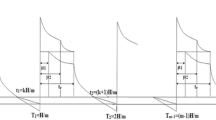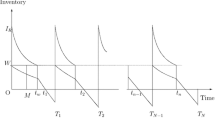Abstract
We consider the problem of a two-warehouse inventory system under the effect of stock dependent demand. There are two warehouses to store the goods in which the first is rented warehouse and the second is own warehouse that deteriorates with two different rates. The aim of this study is to determine the optimal order quantity to maximize the profit of the projected model. Finally, some numerical examples and sensitivity analysis of parameters are made to validate the results of the proposed model.




Similar content being viewed by others
References
Skouri K, Konstantaras I, Papachristors S and Ganas I 2009 Inventory models with ramp type demand rate, partial backlogging and Weibull distribution rate. Euro. J. Oper. Res. 192: 79–92
Wee H M, Yu J C P and Law S T 2005 Two-warehouses with inventory models for partial backlogging and Weibull distribution deteriorating items under inflation. J. Chinese Inst. Ind. Eng. 22: 451–462
Yang H L 2006 Two-warehouse partial backlogging inventory model for deteriorating items under inflation. Int. J. Prod. Econ. 103: 362–370
Lo S T, Wee H M and Huang W C 2007 An integrated production-inventory model with imperfect production processes and Weibull distribution deterioration under inflation. Int. J. Prod. Econ. 106: 248–260
Skouri K and Konstantaras I 2009 Order level inventory models for deteriorating seasonable/fashionable products with time dependent demand and shortage. Math. Problem Eng. 2009: 1–24
Yang H L 2012 Two-warehouse partial backlogging inventory models with three-parameter Weibull distribution deterioration under inflation. Int. J. Product. Econ. 138: 107–116
Chakrabarty T, Giri B C and Chaudhuri K S 1998 An EQO model for items with Weibull distribution deterioration, shortages and trend demand: An extension of Philip’s model. Comput. Oper. Res. 25: 649–657
Dave U and Patel L K 2006 Policy inventory model for deteriorating items with time proportional demand. J. Oper. Res. Soc. 32: 137–142
Ghare P M and Shrader G F 1963 A model for exponentially decaying inventory. J. Ind. Eng.14: 238–243
Giri B C, Jalan A K and Chaudhuri K S 2003 Economics order quantity model with Weibull deterioration distribution, shortages and ramp-type demand. Int. J. Syst. Sci. 34: 237–243
Hariga M A 1996 Optimal EOQ models for deteriorating items with time-varying demand. J. Oper. Res. Soc. 47: 1228–1246
Misra R B 1975 Optimal production lot-size model for a system with deterioration inventory. Int. J. Prod. Res. 13: 495–505
Philip G C 1974 A generalized EOQ model for items with Weibull distribution deterioration. AIIE Trans. 6: 159–162
Teng J T Chern, M S Yang H L and Wang Y J 1999 Deterministic lot-size inventory model with shortage and deterioration for fluctuation demand. Oper. Res. Lett. 24: 65–72
Covert R P and Philip G C 1973 An EOQ model for items with Weibull distribution deterioration. AIIE Trans. 5: 323–326
Goyal S K and Giri B C 2001 Recent trends in modeling of deteriorating inventory. Eur. J. Oper. Res. 134: 1–6
Jaggi C K and Tiwari S 2014 Two-warehouse inventory model for non-instantaneous deteriorating items with price dependent demand and time-varying holding cost. Math. Model. Appl. 225–238
Daultani Y, Kumar S, Vaidya O S and Tiwari M K 2015 A supply chain network equilibrium model for operational and opportunism risk mitigation. Int. J. Prod. Res. 53: 5685–5715
Author information
Authors and Affiliations
Corresponding author
Rights and permissions
About this article
Cite this article
Kumar, S., Singh, A.K. Optimal time policy for deteriorating items of two-warehouse inventory system with time and stock dependent demand and partial backlogging. Sādhanā 41, 541–548 (2016). https://doi.org/10.1007/s12046-016-0490-y
Received:
Revised:
Accepted:
Published:
Issue Date:
DOI: https://doi.org/10.1007/s12046-016-0490-y




